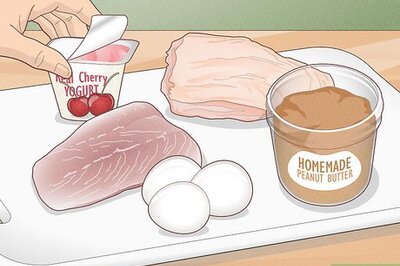
views
T There is no denying that cooking is therapeutic, and when the same is done keeping the health aspect its a bonus. Nita Mehta, a household name in the art of cooking, recently launched a coffee table book, Indian Cooking with Olive Oil. The book features innovative recipes like the Broccoli Peanut Kebabs to traditional Bhagaare Baingan, from healthy Zucchini Oat Crunches to decadent Gulab Jamun, all made healthier with olive oil.Mehta says that the book is a combination of recipes from across the country. “I love travelling and I make it a point to recreate the food I eat in all the places I visit. More often then not, while making those dishes I end up adding a little twist to the dish,” she informs. For someone who has a passion like her’s, Mehat asserts that what is tasty can be healthy as well. “Factors like taste and health must compliment each other when cooking. There is no point in cooking something that is healthy but not tasty or vice versa. One should always be adventurous and experimental in the kitchen,” she adds.For someone who is so conscious of the ‘health factor’ in her cooking, with her new release, she is all set to bust the common myth that ‘olive oil cannot be used for Indian cooking’. “Olive oil is a very healthy oil. However, there are different grades of the oil. Only a certain grade can be used for Indian cooking,” she says. She further clarifies that oils like the extra virgin or pure olive oil is not suitable for the Indian kitchen. “This oil is neutral in taste and so does not affect the spices and flavourings that Indian cooking is all about. Moreover, it is also resistant to heat for long periods of time. Even frying in olive pomace oil gives crisp, non-oily food,” she explains. The smoking point of first (extra virgin) and second (pure) grade of olive oil is very low. As a result, the oil breaks on prolonged heating and consecutively ruins the flavour of the dish. Speaking on the health aspect, Mehta says that the nutritional value of this oil is very high, rich in monounsaturated ‘good’ fats and, when used in daily Indian cooking, can bring easy wellness to your family's diet. “Though it’s grade maybe lower than the other oils, it has all the nutritional value that it’s counterparts have, minus the flavour. Explaining the process she says, “Grade one is the oil which is achieved within 24 hours of picking the olives. That is why it is so rich in flavour. This oil is good for only salad dressing or to make dips. The residue left after pressing the first batch gives the second grade, i.e pure olive oil. The smoking point of this oil is higher than the former and therefore it can be used for light sautéing. After the third pressing, there is no flavour that is left in the oil, but the nutritional value is still intact. This oil is heavier and so very little quantity is required while cooking. Moreover, unlike the usual oils used for deep frying, olive pomace oil doesn’t leave your hands greasy.”While olive oil is good for health, Mehta says that very kitchen must have a variety of oils. “ You could make one dish using a certain oil and make another using a different oil. This way you get all the required nutrients,” she says.




















Comments
0 comment